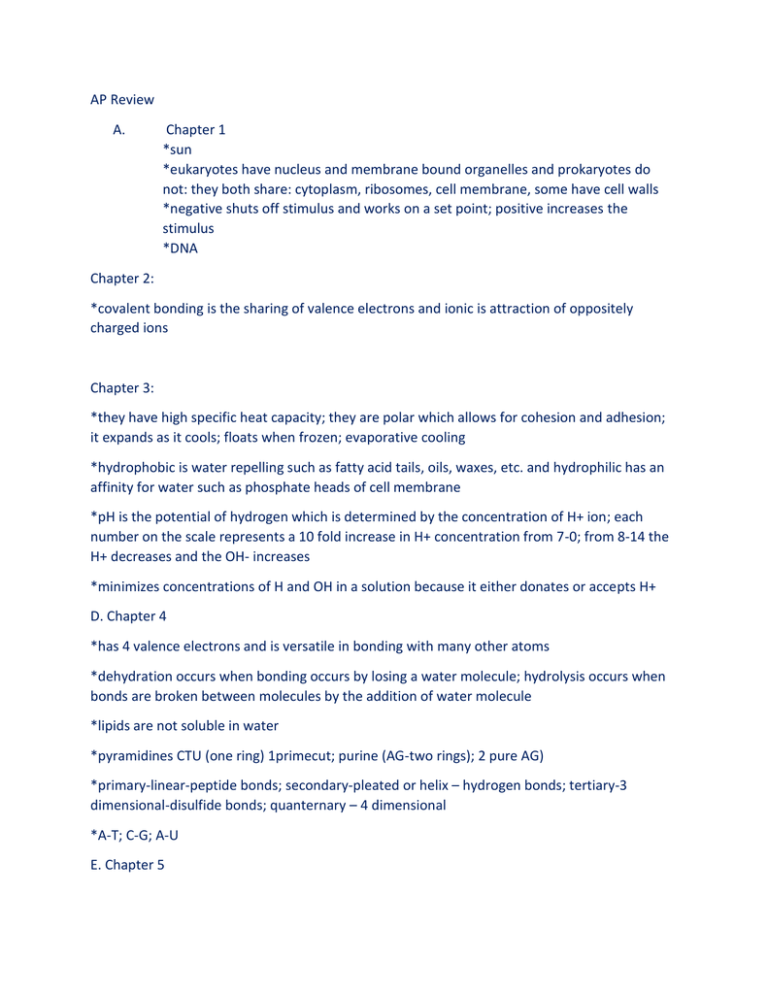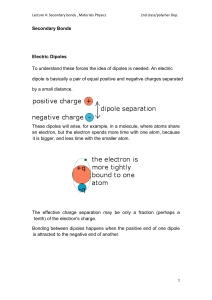review information for mid term
advertisement

AP Review A. Chapter 1 *sun *eukaryotes have nucleus and membrane bound organelles and prokaryotes do not: they both share: cytoplasm, ribosomes, cell membrane, some have cell walls *negative shuts off stimulus and works on a set point; positive increases the stimulus *DNA Chapter 2: *covalent bonding is the sharing of valence electrons and ionic is attraction of oppositely charged ions Chapter 3: *they have high specific heat capacity; they are polar which allows for cohesion and adhesion; it expands as it cools; floats when frozen; evaporative cooling *hydrophobic is water repelling such as fatty acid tails, oils, waxes, etc. and hydrophilic has an affinity for water such as phosphate heads of cell membrane *pH is the potential of hydrogen which is determined by the concentration of H+ ion; each number on the scale represents a 10 fold increase in H+ concentration from 7-0; from 8-14 the H+ decreases and the OH- increases *minimizes concentrations of H and OH in a solution because it either donates or accepts H+ D. Chapter 4 *has 4 valence electrons and is versatile in bonding with many other atoms *dehydration occurs when bonding occurs by losing a water molecule; hydrolysis occurs when bonds are broken between molecules by the addition of water molecule *lipids are not soluble in water *pyramidines CTU (one ring) 1primecut; purine (AG-two rings); 2 pure AG) *primary-linear-peptide bonds; secondary-pleated or helix – hydrogen bonds; tertiary-3 dimensional-disulfide bonds; quanternary – 4 dimensional *A-T; C-G; A-U E. Chapter 5 *as a cell increases in size its volume grows faster than its surface area; surface area to volume decreases with increasing cell size *ribosomes-make proteins; smooth ER-synthesizes membranes Rough ER-contains ribosomes Golgi apparatus – modifies and stores products of the ER and synthesizes some products NucleusS or R ERGolgi apparatus; lysosome – sac with hydrolytic enzymes for breaking down of substances; peroxisome-enzymes that synthesizes hydrogen peroxide as a by productbreaks down alcohol *lipid bilayer that allows passages of materials either by diffusion or facilitated diffusion through transmembrane proteins *saturated fats are solid at room temperature with single bonds; unsaturated are liquid at room temperature due to double bonding Chapter 7 *the spread of molecules from an area of high concentration to a lower concentration *hypotonic is a solute concentration less than inside the cell-cell gains water-plant becomes turgid and animal cell will lyse; hypertonic is a solute concentration greater than inside the cellthe cell loses water and a plant cell will becomes plasmolysized; animal cell will shrivel *facilitated diffusion is the movement of molecules through a protein; active transport moves substances against the concentration gradient requiring energy *phagocytosis-a type of endocytosis in which a cell consumes another cell (cell eating) Chapter 8 *potential energy-energy that matter possess due to structure or location; kinetic energy-is the ability to do work – moving objects *exergonic releases energy and endergonic requires energy *decrease the required energy for a reaction to occur (called activation energy level) *activation energy barrier is the energy needed for a reaction to occur *substrate binds to an enzymes active site by the “induced fit” model and temperature and pH can change the active site thus changing the effectiveness of the enzyme (called denaturation) Chapter 9 *C6H12O6 + 6 O2 6 CO2 + 6 H2O + energy *reduced gains electrons and oxidized is to lose electrons (LEO and GER) (glucose is oxidized and oxygen is reduced) * glycolysis (cytoplasm) it is anaerobic and 2 ATP are produced, glucose is broken down to pyruvate; Krebs cycle (citric acid cycle) 1 ATP produced and carbon dioxide is produced occurring in the mitochondria; oxidative phosphorylation uses the electron transport chain to move electrons from FADH2 and NADH producing 36 ATP, water and occurs in the mitochondrial matrix *aerobic is with oxygen and anaerobic is without oxygen *alcohol produces ethanol and carbon dioxide and NAD+ and lactic acid produces lactate and NAD+ (produces 2 ATP) Chapter 11 *series of steps resulting from a stimulus that amplify the response; signaling molecule binds to receptor on membrane that triggers an inner cellular response which may involve RNA synthesis or secondary messenger system *synaptic is localized signaling occurring in the nervous system and involves an electrical signal along a nerve cell that triggers release of neurotransmitters than carry signal to the target cell across the synaptic cleft; long distance signaling occur via hormones from endocrine system and travel via circulatory system to target cells causing a response Chapter 40 *increases surface area thereby increasing absorption *a part of the brain that maintains homeostasis and coordinates endocrine and nervous system and regulates pituitary gland *controlled by integumentary system that is controlled by hypothalamus Chapter 43 *barrier like skin, mucus, fluids, white blood cells, macrophages, eiosinophils, natural killer cells, neutrophils *mast cells produce histamines and they cause blood vessel dilation allowing the increase of permeability of the blood vessel *provides pathogen specific recognition for long term protection *humoral-B cell receptors and antibodies that bind to extracellular foreign substances in blood and lymph; cell mediated activates cytotoxic T cells to destroy affected host cells *give rise to effector cells when the antigen is encountered a second time; helper T cells stimulate B and T cells *displayes the antigen fragments on the cells surface and presents to the T cells; allows for distinction between self cells and non-self cells; imperative match for organ donation





